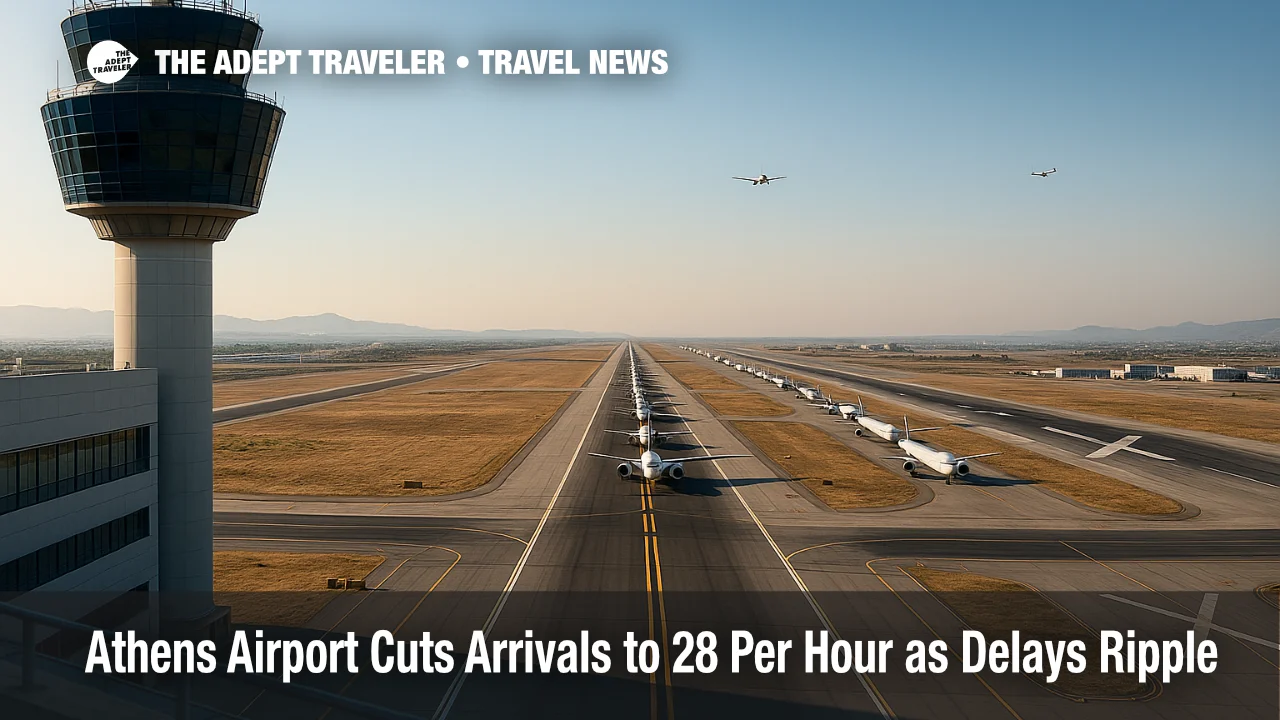Athens Airport cuts arrivals to 28 per hour as delays ripple

Passengers flying to or from Athens International Airport (ATH) should expect significant delays after air traffic controllers limited the number of flights they will handle each hour. Starting September 25, controllers reduced arrival capacity from a summer peak of 36 to 28 per hour, a change that airlines say immediately triggered rolling delays and schedule knock-ons throughout the day. The restriction coincides with government plans to restructure Greece's aviation authority and a broader, multi-year modernization push developed with European partners.
Key points
- Why it matters: Arrivals capped at 28 per hour are producing delays of 20 minutes to as much as 2-3 hours.
- Travel impact: Morning delays of 30-40 minutes often compound into longer disruptions by afternoon and evening.
- What's next: A three-year, 364-action modernization plan is underway; draft CAA reforms are out for consultation.
- Capacity change: Airlines report about a 25 percent cut to ATH arrivals compared with summer scheduling.
- Policy backdrop: Government cites seven action areas agreed with EU bodies; unions argue systems are outdated.
Snapshot
Greece's largest hub is operating under a controller-imposed slowdown that trims hourly arrivals to 28, down from a summertime peak of 36. Aegean Airlines says the roughly 25 percent reduction drove 30-40 minute morning delays that grew as aircraft cycled through their daily rotations. Travelers are seeing anything from brief holds to multi-hour waits when the operation banks up. The move lands amid a political and operational debate over staffing, technology, and the structure of the Hellenic Civil Aviation Authority. Officials say a 364-point, multi-pillar plan is being executed with the European Commission, EASA, and Eurocontrol. Controllers counter that outdated systems and regulatory breaches, not wages or fees, are at the heart of reliability problems.
Background
This summer, Athens drew criticism from some carriers over punctuality and infrastructure, intensifying scrutiny of Greece's air navigation services. The Transport and Infrastructure Ministry recently opened public consultation on legislation to transform the CAA into a legal entity under public law, aimed at speeding routine decisions and granting greater administrative autonomy. In parallel, the government has outlined a three-year aviation modernization program, citing 364 actions across seven workstreams developed with DG MOVE, EASA, and Eurocontrol. Controller representatives say they asked for further meetings in September and reject portrayals of high pay, pointing to Eurocontrol benchmarking that places Greece's provider near the bottom on payroll cost per flight hour while ranking highly on productivity. They argue the immediate constraint is technology and compliance, not fees.
Latest developments
Controllers cap arrivals; Aegean warns of compounding delays
Athens controllers limited throughput beginning September 25, setting arrivals to 28 per hour after periods as low as the low-20s during the transition. Euronews and local outlets report typical delays of 20 minutes to several hours while the cap is in effect. Aegean confirmed an approximate 25 percent reduction in arrival capacity, with morning delays of 30-40 minutes that lengthen as rotations stack up. Passengers should monitor flight status closely and build extra connection time, especially for evening departures when daylong slippage peaks. Authorities say broader European airports are also under strain, and Greece's reform package is intended to relieve structural bottlenecks.
Analysis
For travelers, the headline is straightforward: fewer landing slots per hour inevitably translate into queues aloft and at gates, which then cascade across the schedule. Athens' banked operations magnify this effect; morning pushes compress recovery windows, so a 30-minute slip at 8 a.m. can easily become 90 minutes by mid-afternoon as aircraft and crews miss turns. The 28-per-hour cap represents a sizable step down from the summer ceiling, and while safety-motivated metering is common, prolonged caps signal deeper constraints in staffing, tools, or both.
Policy context matters here. Greece's 364-action plan, with seven cited pillars and EU coordination, indicates an intent to tackle technology, governance, and staffing holistically. Turning the CAA into a public-law entity could accelerate procurement and everyday operations that now require ministerial signatures. Meanwhile, Eurocontrol benchmarking supports the union's claim that Greek air navigation services rank low on payroll cost per flight hour while achieving high productivity, complicating a narrative focused on wages alone. Short term, travelers should expect rolling delays and schedule thinning as airlines adjust. Medium term, measurable relief depends on how quickly Greece executes system upgrades and institutional reforms.
Final thoughts
Until throughput increases, plan conservatively if you are connecting through Athens. Check flight status frequently, consider earlier departures to preserve buffers, and avoid tight self-connections. The government's modernization plan could improve resilience, but implementation will take time. For now, the 28-per-hour arrivals cap at Athens International Airport will continue to define the traveler experience, and anyone transiting the Greek capital should expect variability, longer lines, and potential misconnects tied to the current Athens Airport delays.
Sources
- Athens Airport hit by delays after air traffic controllers limit the number of flights per hour, Euronews
- Announcement on reduced arrival capacity and resulting delays, Aegean Airlines press release (September 26, 2025)
- Athens Airport sees flight delays as controllers limit arrivals; CAA reform context, Greek Travel Pages
- Draft law to transform the Civil Aviation Authority opened for public consultation; minister statement on seven action areas, AMNA
- Greece announces three-year aviation modernization with Eurocontrol and EASA; 364 actions, Greek Travel Pages
- ACE Benchmarking Report 2025 edition; cost and productivity context, Eurocontrol
